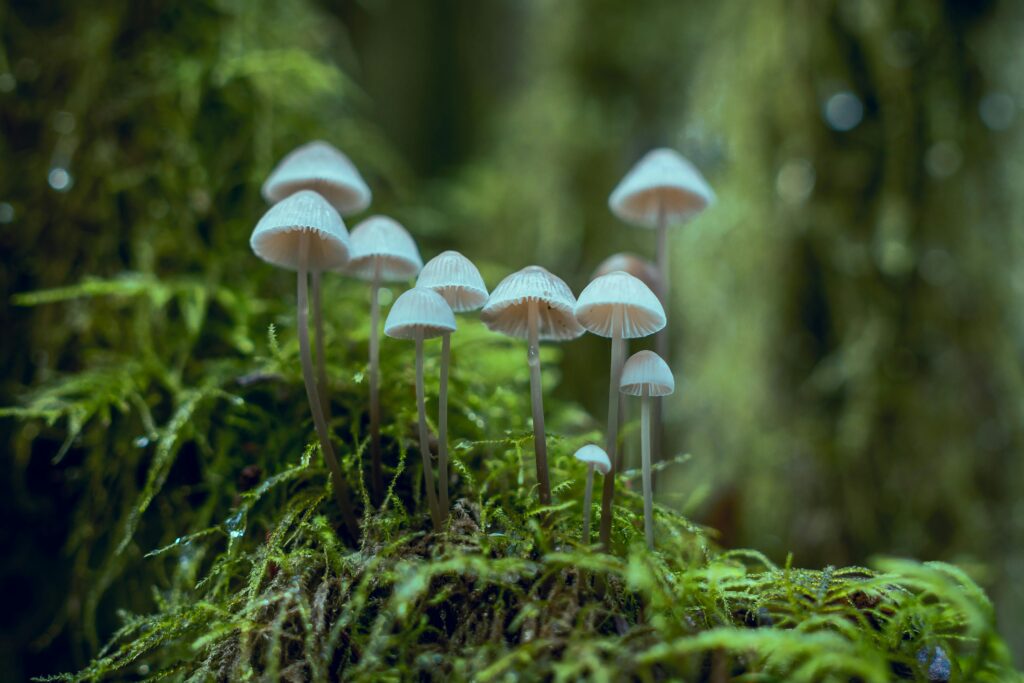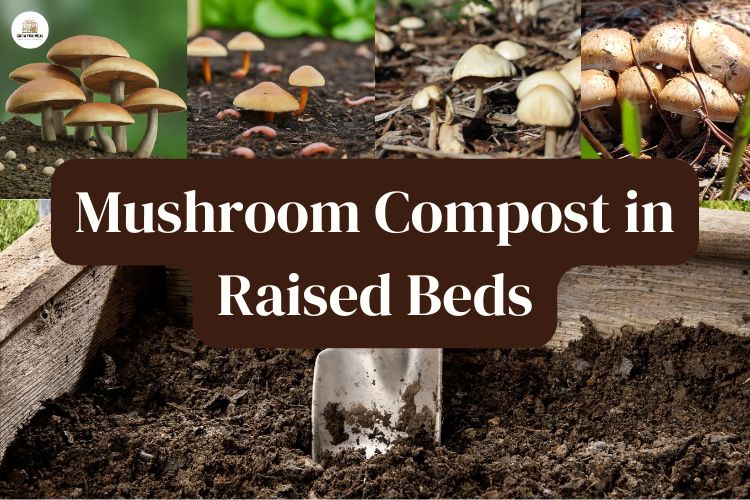Have you ever heard of “mushroom compost” and wondered what the hype is all about? If you’re like many gardeners, you might be surprised to discover that this nutrient-rich blend is often overlooked, yet it can be a game-changer for your organic garden.
Think of mushroom compost as the unsung hero of gardening—a fantastic soil amendment that can turn your raised beds into vibrant, thriving ecosystems.
So, what is mushroom compost exactly? It’s a byproduct of mushroom farming, typically made from a mix of organic materials like straw, hay, and horse manure used to grow mushrooms. After harvesting the mushrooms, the leftover material is composted, resulting in a rich, earthy product packed with nutrients.
Mushroom compost is gaining popularity among eco-conscious gardeners for several reasons. It not only enriches the soil but also supports sustainable gardening practices by recycling waste from mushroom production.
Plus, it significantly improves soil health, enhances water retention, and promotes robust plant growth. With its many benefits, it’s time to shine a light on this underutilized gem in our gardens!
Are Mushrooms Good for Compost?
What is Mushroom Compost?
Mushroom compost is a nutrient-rich organic material made from the byproducts of mushroom cultivation. It primarily consists of materials like hay, straw, and horse manure, which serve as a growing medium for mushrooms.
After harvesting, the leftover substrate is composted, resulting in a dark, crumbly substance bursting with nutrients. This compost not only improves soil structure but also enriches it, making it a perfect addition to any organic garden.
Nutritional Value for the Soil
The magic of mushroom compost lies in its rich organic matter. As mushrooms break down the compost materials, they leave behind a treasure trove of nutrients essential for plant growth.
This compost is loaded with nitrogen, phosphorus, potassium, and other vital micronutrients that plants crave.
Its balanced nutrient profile promotes strong root development and enhances overall plant health. Additionally, it improves soil texture, allowing for better aeration and drainage—particularly beneficial in raised beds.
Environmental Impact
Using mushroom compost isn’t just great for your garden; it’s also a sustainable choice for the environment.
By recycling the growing mediums from mushroom farming, we reduce waste and contribute to a more circular economy. Instead of being tossed aside, these materials find new life in our gardens, enriching the soil and decreasing the need for chemical fertilizers.
This eco-friendly approach aligns perfectly with the principles of organic gardening, making mushroom compost a responsible choice for anyone looking to garden sustainably while enhancing plant health.
Using Mushroom Compost in Raised Beds
Soil Health Booster
Mushroom compost is an excellent soil health booster, especially in raised beds. When you mix it into your soil, you’re not just adding nutrients; you’re also improving the soil’s overall structure.
The organic matter in mushroom compost creates a loose, crumbly texture that enhances aeration, allowing plant roots to breathe and access essential nutrients more effectively.
Moreover, this compost excels at moisture retention. It acts like a sponge, soaking up water and releasing it gradually—particularly beneficial during dry spells.
With improved water retention and aeration, plants can establish stronger root systems and grow more vigorously, making mushroom compost an ideal addition to your raised beds.
Compatibility with Different Plants
While mushroom compost offers many benefits, it’s essential to know which plants thrive in it. Most vegetables, herbs, and flowers appreciate the rich nutrients and improved soil structure that mushroom compost provides. Crops like tomatoes, peppers, lettuce, and cucumbers particularly flourish with this compost.
However, some plants may not thrive as well. Salt-sensitive plants, such as blueberries, might struggle in mushroom compost due to its potential salt content. Research specific plant needs and test the compost in small amounts to see how well your chosen plants respond before using it extensively.
Application Tips
To maximize the benefits of mushroom compost in your raised beds, consider these practical application tips:
- Mixing Ratios: Aim for a blend of about one part mushroom compost to two parts garden soil. This ratio allows for sufficient nutrient infusion while maintaining soil structure.
- Layering: If you’re starting with new raised beds, consider layering mushroom compost at the bottom. This creates a nutrient-rich foundation that will gradually feed your plants as the compost breaks down.
- Incorporation: Ensure the mushroom compost is well-integrated into the existing soil. Use a garden fork or tiller to achieve even distribution throughout the bed.
- Regular Top Dressing: For ongoing benefits, apply a layer of mushroom compost as a top dressing around your plants once or twice a season. This practice helps maintain soil health and provides additional nutrients as the compost breaks down.
Mushroom Compost as Mulch

Benefits as Mulch
Using mushroom compost as mulch offers various benefits that can enhance your garden’s health. One major advantage is its ability to suppress weeds. A thick layer of mushroom compost blocks sunlight, making it difficult for weed seeds to germinate and establish themselves.
In addition to weed suppression, mushroom compost excels at moisture retention. It helps keep the soil cool and moist, reducing how often you need to water. This consistent moisture is particularly beneficial for plants that thrive in steady conditions, especially during dry spells.
Lastly, mushroom compost provides slow-release nutrients as it breaks down. This gradual nutrient release nourishes your plants, ensuring they receive essential elements without the risk of nutrient burn often associated with synthetic fertilizers.
How to Apply Mushroom Compost as Mulch
Applying mushroom compost as mulch in your raised beds is simple. Follow these steps to get started:
- Prepare the Area: Begin with clean, weed-free beds. Remove any existing weeds manually or with a hoe.
- Water the Soil: Before applying mulch, water your raised beds to ensure the soil is moist. This helps the mushroom compost settle better and improves moisture retention.
- Spread the Compost: Use a shovel or garden fork to evenly distribute a 2- to 3-inch layer of mushroom compost over the soil surface. Keep the compost a few inches away from the base of your plants to prevent potential rot.
- Smooth It Out: Rake the compost to create an even layer, ensuring uniform coverage. This maximizes its benefits for weed suppression and moisture retention.
- Monitor and Replenish: Over time, the compost will break down and may need replenishing. Keep an eye on the mulch layer; when it appears to be thinning, add another layer of mushroom compost as needed.
Potential Drawbacks
While mushroom compost offers many benefits, a few potential drawbacks exist. One concern is its salt content. Some mushroom compost can have higher levels of soluble salts, which may not be suitable for all plants, especially salt-sensitive varieties.
To mitigate this issue, consider aging the compost before applying it as mulch. Allowing the compost to sit for a few weeks or even months can help reduce its salt levels, making it safer for your plants.
Additionally, mixing it with other organic materials can further dilute the salt concentration, creating a healthier environment for your garden.
A Valuable Tool for Organic Gardeners
Incorporating mushroom compost into your raised beds can truly transform your organic gardening experience.
This nutrient-rich compost improves soil structure, enhances moisture retention, and delivers slow-release nutrients, making it a powerhouse for healthy plant growth.
It not only suppresses weeds but also offers a sustainable way to recycle materials from mushroom farming, perfectly aligning with eco-friendly gardening practices.
As you explore the benefits of mushroom compost, don’t hesitate to experiment with it in your garden. Whether you want to boost soil health, retain moisture, or create a thriving ecosystem for your plants, mushroom compost is a valuable ally.
By adding this simple ingredient to your raised beds, you take a step toward a more sustainable and nutrient-rich garden that will flourish for seasons to come. Happy gardening!





Pingback: Compost vs. Mulch: What Every Veganic Gardener Needs to Know - GrowForMeal